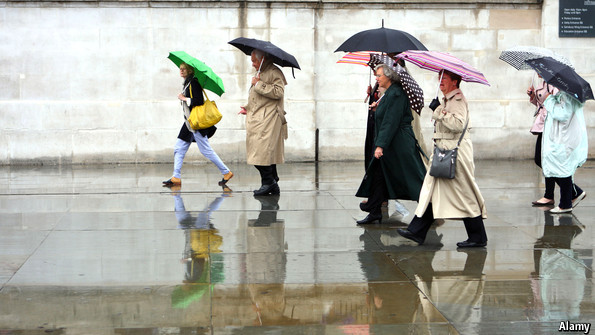London Strolling
from The Economist:
 Urban pedestrians buck a national trend
Urban pedestrians buck a national trend
Aug 3rd 2013
LONDON is a city made for walking. Unlike, for instance, Los Angeles its centre is easily accessible on foot. Outer boroughs are no more than an hour or two away. Its curved streets, in contrast to the rigid grid of New York, welcome idle wanderers and busy commuters alike. But despite traffic queues and teeming underground carriages most prefer to drive or to squeeze on to the Tube to get around the city. This is starting to change.
Between 2001 and 2011 the number of trips made daily on foot in London increased by 12%. Nearly a third of the Londoners sampled made a continuous walk of 30 minutes once a week between 2010 and 2011 to get from place to place, rather than for exercise. Each day 6.2m walks are made across the city.
And both rich and poor walk a similar amount. In areas such as Kensington and Chelsea 11% walk for at least 30 minutes five times a week or more. In Tower Hamlets 12% of residents do. One of the largest changes in the city over the past decade is the number of pedestrians, says Michèle Dix of Transport for London (TfL), which runs the city’s transport networks. On July 10th TfL launched the Roads Task Force, with plans to spruce up pavements.
Several reasons account for the walking boom. The number of Londoners increased by 12% from 7.3m in 2001 to 8.2m in 2011, and Tube trains are broiling and overcrowded. But other factors also encourage pedestrians. In 2004 Ken Livingstone, then mayor of London, vowed to make London a “walkable city”. Some of his plans were carried on by Boris Johnson, the current mayor. These include a scheme to create clearly-marked maps for use across the city. Of 33 boroughs in London 22 now have the distinctive yellow-branded signs on their streets. All TfL-owned property (such as Tube stations and bicycle-hire points) is covered by the scheme. This deters tourists from popping on the Tube to travel one stop from Covent Garden to Leicester Square, a distance of 0.3m (0.5km) says Tony Armstrong of Living Streets, a charity for pedestrians. ........................(more)
The complete piece is at:
http://www.economist.com/news/britain/21582576-urban-pedestrians-buck-national-trend-footfalls?fsrc=scn/tw_ec/footfalls
